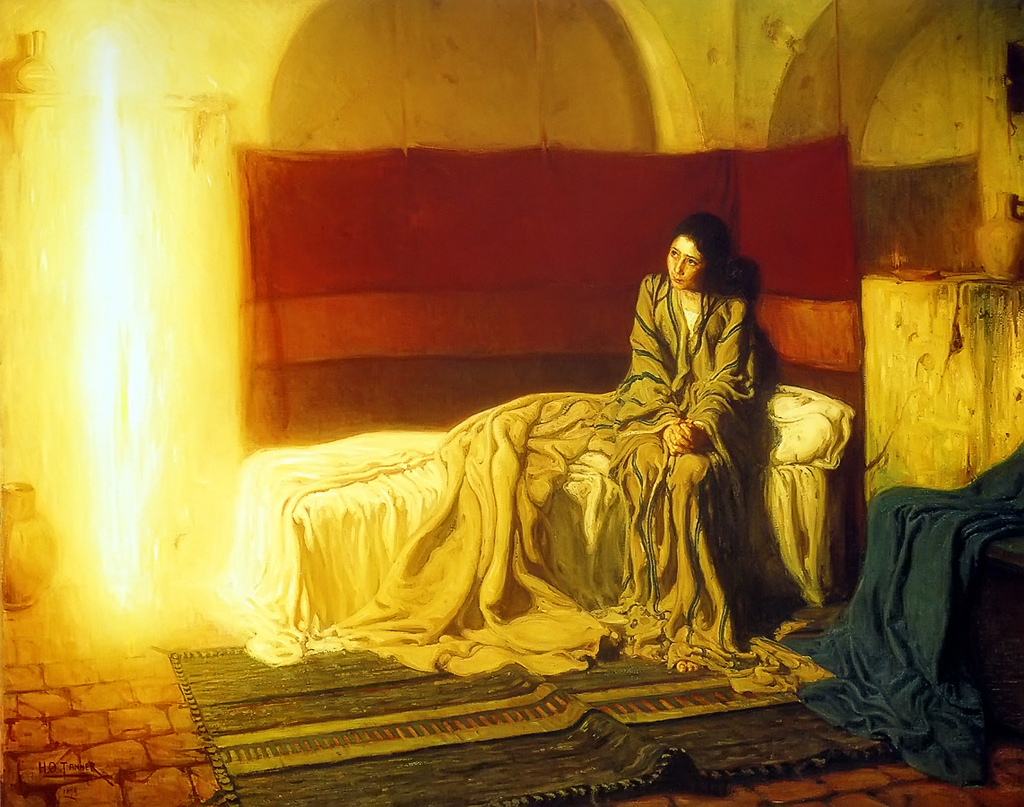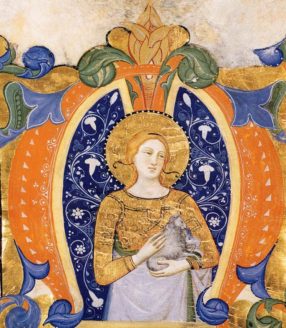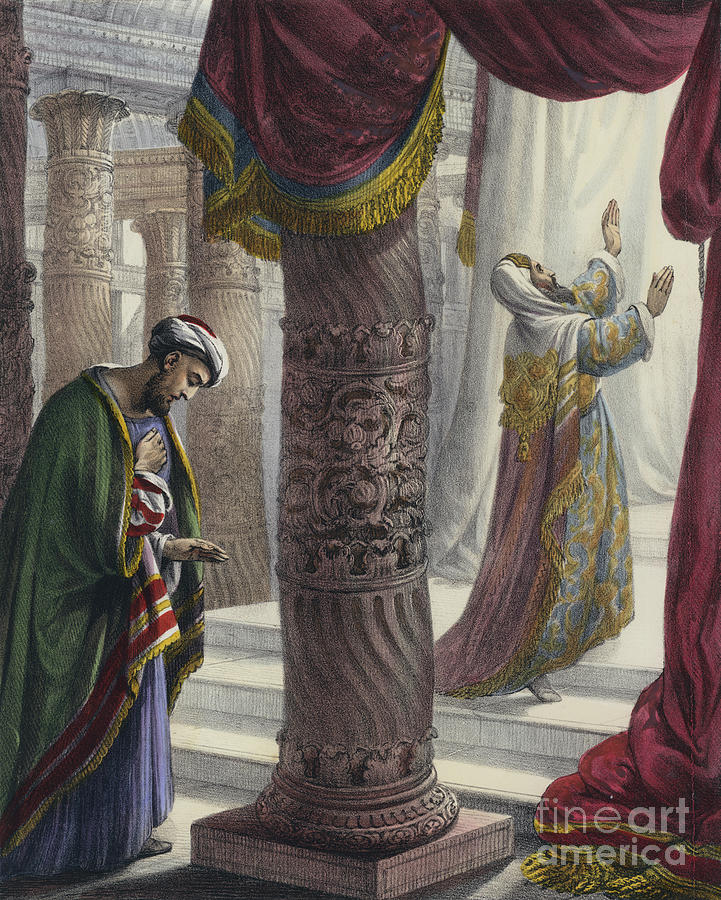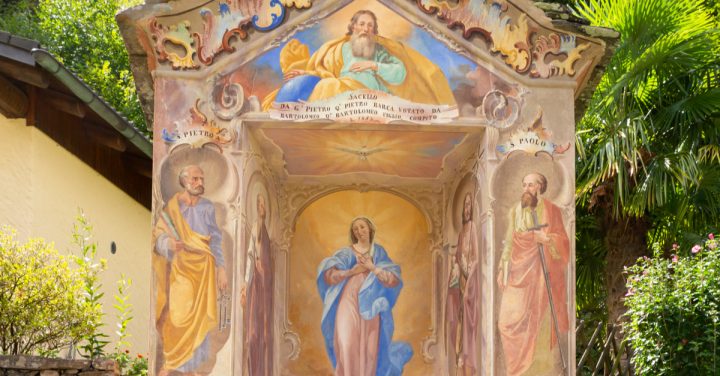Viewing and pondering sacred art offers the faithful a great way to prepare for the birth of Our Blessed Lord at Christmas. This series of articles will highlight several pieces of art related to the Gospel readings of this year’s lectionary cycle, as well as two pieces related to the week leading to Christmas. Each of these pieces of art allows us to reflect deeply on God’s plan for our lives, and to be prepared for the joyful celebration of Our Lord’s Nativity.
During these seven days leading up to Christmas, December 17 to 24, the Gospel readings provide us with the full story of God’s preparation for the birth of Our Blessed Savior. In the middle of that series, we hear the story that is probably most obviously connected to Advent. We are told of the Annunciation, the moment when Mary was presented with her call to bear the Son of God to the world (Luke 1:26-38). Mary’s fiat, her “yes” to God’s plan, specifically opens the way to the Nativity at Bethlehem.
This moment has been depicted often and very beautifully in sacred art throughout Christian history. Think of Fra Angelico’s Annunciation, for example. One of the finest of those depictions is by the American artist, Henry Ossawa Tanner. The Annunciation was painted in Paris in 1898, and its use of light and color has captivated Christian disciples ever since. This piece of art, with its intricate details to tell the story, provides a fantastic opportunity for us to meditate on the reality of Advent and hope fulfilled in Jesus.*

Tanner brings viewers to the authentic setting of a home in the ancient near east. Small details like a ruffled rug and an earthen jar add ambiance. The teenage girl, who is the focal point of the painting, sits on an unmade bed in a room that is partitioned from the rest of the house. As we meditate on this painting, these details can be indicative of our own minds, hearts, and lives, especially during Advent. Perhaps our proverbial houses for Jesus, our souls, are untidy or even unclean. This is why we need to access the Sacrament of Reconciliation during Advent. We need make a suitable dwelling place for Jesus by tidying the messy areas of our souls.
In the center of the painting, we see Mary of Nazareth. Her folded hands indicate that she has been and continues to be in prayer. The look on her face gives the indication that we are privy to the moments while Mary is in dialogue with the angel, before her assent to the divine will. In the biblical narrative, listeners are informed that Mary was “greatly troubled” at Gabriel’s greeting, “Hail, full of grace.” This image seems to capture the moments while Mary “pondered what sort of greeting this might be.” Advent makes a great time for each of us to reflect on how God wants to greet us and bring us many graces and blessings. Sure, none of us is “full of grace” like Mary, but God does want to bring each of us closer to Himself. Does that reality perplex and trouble me? Can I empathize with Mary’s uncertainty about God’s plan? Can I bring this confusion to God and have a prayerful conversation about it?
After we take in these details, we notice the object of Mary’s gaze, the column of fiery light in another corner of her room. In his description of the Annunciation, Ven. Fulton Sheen called Gabriel the “Angel of Light [who] came down from the great Throne of Light….”** Here, Tanner has captured Sheen’s description and provided us with one of the best depictions of an angelic being in all of sacred art. Light, of course, is an appropriate theme during Advent. Light from the candles on Advent wreaths pierces the deepening darkness of winter. We anticipate that the Light of the World is coming into the world. Each of us might find it beneficial to spend a moment reflecting on how God’s light has come into our lives; and how He might want to bring more light to us and through us.
Recognizing these things allows us to be drawn deeper into the remainder of the conversation. Gabriel speaks: “Do not be afraid, Mary,” and “Behold, you will conceive in your womb and bear a son….” These two statements are intimately connected to God’s movement throughout salvation history. Every time that God asks His people to take on a challenging task or mission, something that will bring abundant grace, He tells them not to fear. Throughout salvation history, sons have also held an important place: Isaac, Jacob, Joseph, and Solomon all point to the Incarnate Son of God who will reign on the throne of the everlasting Kingdom. Advent is a time to examine our personal history, and to ask how He will help us overcome the fear that keeps us from living out His plan for our lives.
In her exchange with Gabriel, Mary queries, “How can this be…?” (Lk. 1:34). Mary trusts God’s message, but she wants to know how this will come about. Gabriel tells her first that “the power of the Most High will overshadow you,” and then he announces to her Elisabeth’s miraculous pregnancy. It is not inappropriate to ask God for verification about what He wants from us or to do in us. Advent is a great time to sit in the same posture as Mary, asking for clarity or verification about God’s plan for our lives.
The biblical story tells about the final outcome. After this intense moment of prayer in which the recipient of God’s message was confused, perplexed, and overwhelmed, Mary gives her consent, her fiat. She refers to herself as the “handmaid of the Lord,” which is a position of humility and assistance. During Advent, each of us can echo Mary’s fiat by giving our consent for God to work in us by unusual and miraculous means; work that aids in His plan; work that will bring us to the fullness of who we are meant to be.
This piece of art provides at least part of a magnificent visual culmination of the Advent season. Coupled with the biblical narrative, this painting brings to life several of the most important themes of our spiritual lives, themes that we need to recognize and cultivate during Advent and every other season. Here’s hoping that each of us makes our own respective fiat during this holy season, and we allow the Incarnate God to be formed in us for the sake of the world.
✠
*NB: The Annunciation, by Henry Ossawa Tanner, is on display at the Philadelphia Museum of Art. Reproductions are in the public domain.
**From Fulton Sheen, Life of Christ



